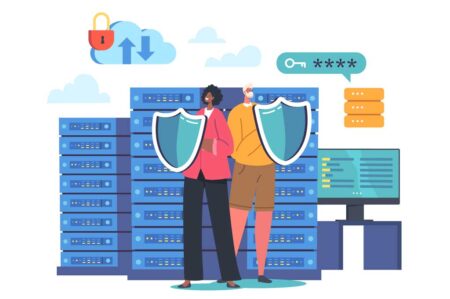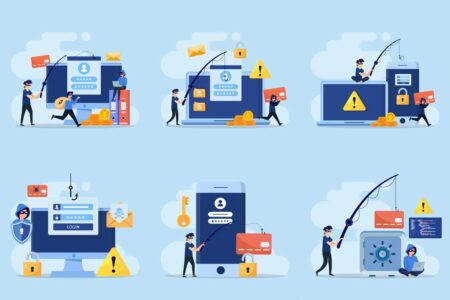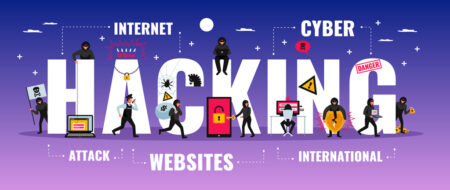The pandemic thrust many businesses into remote operations before they were ready. Along with other challenges, securing the operations of remote teams has proven difficult.
The pandemic has forced many businesses across the world to rethink the concept of “the office.” While remote workforces were trendy before the pandemic, they became a necessity shortly after the onset. Many businesses that were previously averse to remote teams are now seeing tons of value in this style of operations – which means this trend of working from home will likely continue well after the virus is gone.
Working from home has tons of benefits for both a business and its team members. But those benefits inevitably come with some risks.
One of the biggest issues with remote teams is cybersecurity. Working remotely makes your team more vulnerable to cyberattacks that not only threaten the employees’ personal information and data, but also put your business and customers at risk.
There are several ways to ensure your company data’s privacy and protection. This article will guide you through the nitty-gritty of online threats and how you can tackle them like a pro to make sure your remote team is just as secure as they would be in your office.
Security risks of remote work
Your business has likely been the target of some type of attack at some point, whether or not it was successful or you were aware of it. At the very least, cybercriminals have probably tried to determine the viability of targeting your business. When your team worked in the office, they were probably always under the protection of firewalls, blacklists for certain IP addresses, cutting-edge VPNs, and your company’s intranet. Now, with your team distributed across the country (or the world), you are more vulnerable than before.
To help you limit the risks associated with your team working from home, here are some things you need to consider.
Connecting to unsecured networks
Remote work doesn’t always mean working strictly from “home” as we typically define it. In the true sense of the concept, working from home (or working remotely) can involve team members working in cafes, shared workspaces, or public places like the library, using unsecured Wi-Fi networks.
It’s critical for your team to know that connecting to a public network comes with its own privacy issues. When you connect to a public Wi-Fi network, you expose your computer and data to harmful spyware. These malicious cyberattacks are always on the lookout for weaknesses to exploit.
Phishing attacks
Phishing attacks are a textbook threat to your data. These attacks are easy to overlook, and anyone who lacks awareness can fall victim to them. Recent research shows an increase of over 600% in phishing attacks since February. Cybercriminals are taking advantage of a bad situation with an increased number of attacks since the virus showed up.
Phishing involves using a makeshift master copy of a reputable website or sending authentic-looking emails that ask you to log in to the site or respond to the email with sensitive information. When you take these actions, the criminals steal your data.
This is not just a threat to your team members’ security but a systematic risk to your whole organization, as each of your team members’ remote workstations will include your organization’s login credentials to different programs, giving criminals access to all kinds of data.
Mobile security threats
Mobile device security is often overlooked and not prioritized, even though these devices are the easiest to compromise. Working remotely, your employees may use their mobile devices to complete any number of tasks, save valuable information, or communicate with the rest of the team.
There are two specific ways for cybercriminals to take advantage of your business through insecure mobile devices:
- Smishing: These are organized phishing attacks sent in text messages rather than emails. They employ the same mode of acquiring information, prompting users to click malicious links or download malware.
- Bring your own device (BYOD): Most company-owned computers, laptops, and mobile devices are equipped with state-of-the-art antivirus software, firewalls, and VPNs to protect your organization’s data. However, with the increasing popularity of BYOD, employees are encouraged to use their own devices for work, and these devices rarely have adequate protection against malicious attacks.
It may cost your organization more, but if you plan to allow your team to use mobile devices in operations related to your organization, you may want to fork over the money to make sure the devices are secure.
Security tips for working remotely
Despite all the risks involved in operating your business remotely, there are plenty of security measures you can take to limit the risk. Let’s look at a few things you can put in place to protect your data and maintain smooth, safe remote operations.
Virtual private networks (VPNs)
VPNs are a goldmine for users who wish to hide their digital footprint. They suppress your IP address by means of a server that acts as a medium. For example, you could be sitting in Singapore, but a VPN will mark your IP address as one from the U.K. (or wherever you prefer) if you use a VPN.
This can be useful when you or someone on your team is connected to an unsecure or unfamiliar network, such as the Wi-Fi at a local coffee shop or bookstore. These networks are often not encrypted, making your password vulnerable to theft. Setting up on a VPN makes it much more difficult for criminals to target your laptop or mobile device.
Antivirus software
It is essential to provide resources to your team that ensure the documents they are working on are safe from being corrupted or deleted entirely. Work documents often contain highly sensitive information, and opening up this information to criminals could be devastating to your organization.
Fortunately, there is a simple solution here: Set your team up with high-quality antivirus software.
There are several antivirus solutions out there made precisely to address these concerns. Some antiviruses are free, while others are available at premium rates. If you can’t afford a paid one, I highly recommend getting a free version to ensure you have at least minimal protection. [Check out our picks and reviews for the best antivirus software.]
Device lock
Most of the security threats discussed throughout this article are online cyberattacks. However, not all such attacks occur in the digital world. In some cases, your team members’ devices could be physically stolen. This is why it’s critical for them to lock their devices if they are going to leave them unattended.
Locked devices, if stolen, can be super challenging to unlock for access to their stored data. It’s possible, but certainly a lot harder than it is to break into an unlocked device.
In addition to locking, stress to your team the importance of using a hard-to-guess password. Too often, people use passwords that are easy for them to remember. The problem is, those passwords are also easy for criminals to guess.
USB data blockers
You may be aware that anyone can steal your data through a USB port. (Yes, you read that right – a USB port.) Data pins on the USB heads allow access to data within the device connected to the port. But rest assured, there is a way to overcome this issue – through USB data blockers.
These blockers act as a bridge between your device and the USB port. The blockers have no pins through which data can be transmitted, so your data remains secure even if you plug your device into a charging station in a public area.
Wrapping it up
Working remotely has become a necessity for many businesses, and it looks like it may be here to stay. While the transition to remote operations has been challenging for many, it’s critical that you ease the burden of security by taking the above actions and requiring secure practices from your employees.
Remote workers across the country have struggled with things like productivity, avoiding distractions, and missing out on office interaction. Too often, though, companies neglect to think about the security associated with working from home. It’s also vital to recognize that threats don’t just lurk on the internet; they can also manifest physically.
Fortunately, there are protocols and solutions available to protect against each of these dangers, as long as your organization puts in the time, effort, and sometimes money to use them effectively. Dig in and do your research to make sure your remote operations are as secure as possible.


